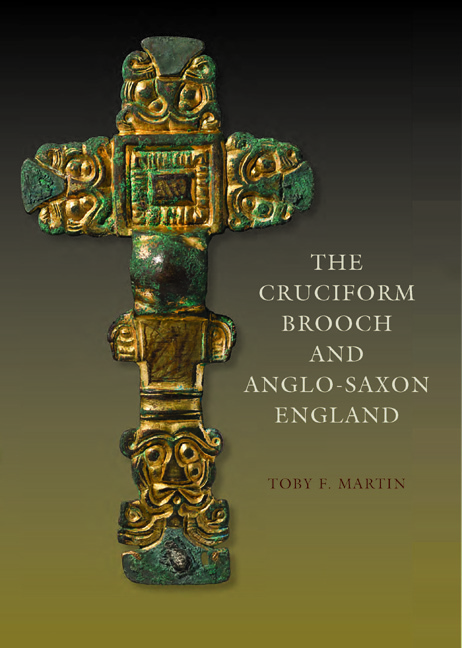Book contents
- Frontmatter
- Dedication
- Contents
- List of Illustrations
- Preface
- Acknowledgements
- 1 The Anglian Brooch par excellence
- 2 A New Typology for Cruciform Brooches
- 3 Building a Chronological Framework
- 4 Cycles of Exchange and Production
- 5 Migrants, Angles and Petty Kings
- 6 Bearers of Tradition
- 7 Cruciform Brooches, Anglo-Saxon England and Beyond
- Appendix 1 Cruciform Brooches by Type
- Appendix 2 Cruciform Brooches by Location
- Appendix 3 A Guide to Fragment Classification
- Bibliography
- Index
- Plate Section
1 - The Anglian Brooch par excellence
Published online by Cambridge University Press: 05 May 2015
- Frontmatter
- Dedication
- Contents
- List of Illustrations
- Preface
- Acknowledgements
- 1 The Anglian Brooch par excellence
- 2 A New Typology for Cruciform Brooches
- 3 Building a Chronological Framework
- 4 Cycles of Exchange and Production
- 5 Migrants, Angles and Petty Kings
- 6 Bearers of Tradition
- 7 Cruciform Brooches, Anglo-Saxon England and Beyond
- Appendix 1 Cruciform Brooches by Type
- Appendix 2 Cruciform Brooches by Location
- Appendix 3 A Guide to Fragment Classification
- Bibliography
- Index
- Plate Section
Summary
Almost exactly a century ago Edward Thurlow Leeds, in what might justifiably be called the founding work of early Anglo-Saxon archaeology, described the cruciform brooch as the ‘Anglian brooch par excellence’. It was the distribution of cruciform brooches in the eastern half of England along with their appearance here following the fall of Roman Britain that inspired Leeds to make such a grand statement (Figures 1 and 2). The Anglian cultural zone, which is represented not just by cruciform brooches but by a few other types of jewellery, was a persevering material phenomenon in the region for most of the fifth and sixth centuries AD. The historical significance of this particular locality was echoed two centuries later in Bede's Historia Ecclesiastica Gentis Anglorum, which stated that this region was the one settled by migrants from Angulus in modern-day Schleswig-Holstein, northern Germany. Of course, our understanding of the term ‘Anglian’ has changed considerably since Bede's and even Leeds' accounts. Cruciform brooches no longer represent a distinct group of migrants who arrived on these shores from northern Germany along with the Saxons and Jutes, dressed in the distinctive jewellery of their homelands. This is an unrealistically simplified account resembling an origin myth more than it does actual processes of migration and identity formation. Nor can we be quite so quick to imply that earlier Germanic mercenaries, brought to these shores by the British tyrant Vortigern to defend against their invading cousins, decorated their wives with cruciform brooches, whether they were of native or Germanic stock. Even so, Leeds' turn of phrase still holds a resonance we would be injudicious to discard. Cruciform brooches have become iconic of eastern Anglo-Saxon England and their relative abundance makes them fundamental to understanding regional identity in this period, whatever the name we decide to give it. Thanks also to their elaborate decoration and high numbers of incidences in recorded grave contexts, cruciform brooches are archaeological objects par excellence for being an exceptionally rich source of social and cultural information.
- Type
- Chapter
- Information
- The Cruciform Brooch and Anglo-Saxon England , pp. 1 - 11Publisher: Boydell & BrewerPrint publication year: 2015

